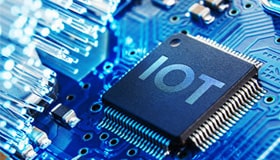5G - What is 5G, capabilities and its applications
The twenty-first century is the "connected" century; wireless communication technology advanced at a rapid pace in succeeding years as a result of research and invention. After the emergence of 4G wireless mobile technology, researchers and mobile operator industries began to look into the progress (technological) towards 5G communication technology due to certain major needs such as increased data rates, increased capacity, reduced latency, and improved QoS. (Quality of Service).
Fifth-generation (5G) wireless technology, which includes enhanced access technologies such as BDMA (Beam Division Multiple Access) and FBMC (Filter Bank Multi-Carrier Multiple Access), will easily replace fourth generation (4G) wireless technology. 5G will not only be faster than the current 4G, but it will also have the potential to revolutionize other sectors such as manufacturing, automotive, health care, and energy. It will allow the transition from wired to wireless connectivity in a wide range of industrial environments. This article explains 5G, its capabilities, and applications.
What is 5G & its capabilities
5G Technology stands for Fifth Generation, which is the next generation of wireless network technology, designed to broaden the reach of mobile technology beyond LTE's capabilities. It is the most recent version of cellular technology. 5G is distinguished by three key characteristics: faster speeds, lower latency, and the ability to connect many devices at the same time. Because of higher accessible bandwidth and new antenna technology, 5G enables a significant increase in data quantities sent through wireless systems. mmWave (millimeter-wave) technology powers these 5G networks.
5G technology will change the way cell phones are used in areas with very high bandwidth, such as 1Gbps or more. People will encounter unprecedented levels of call volume and data transmission when 5G is pushed over a VoIP-enabled device. 5G technology will provide services such as ubiquitous networks, radio resource management, high altitude stratospheric platform station (HAPS) systems, and so on.
5G wireless technology is a significant advancement over previous generations. It solves all prior disadvantages, such as a lack of coverage, lack of performance at cell edges, and dropped calls. 5G promises better coverage and connectivity.

Figure1: Comparison table of all generations
How 5G Works
The introduction of 5G technology has resulted in advancements in network design. The 5G New Radio, hailed as the worldwide standard for a better 5G wireless air interface, includes spectrums that were previously unutilized in 4G. Massive MIMO (multiple inputs, multiple outputs) technologies are used for the new antennas, allowing many receivers and transmitters to transfer massive amounts of data at the same time.
However, 5G technology is not limited to New Radio. It strengthens a convergent and heterogeneous network that combines unlicensed and licensed wireless technologies. This increases the level of bandwidth available to users.
5G enhances digital experiences through machine-learning (ML)-aided automation. The requirement for fractions of second response times (for example, self-driving vehicles) pushes 5G networks to create automation with ML and, in the long run, artificial intelligence (AI) and deep learning (DL). Active management and automated service and traffic provisioning improve the connected experience while also reducing infrastructure expenses.
5G technologies and techniques
Several technologies and approaches have been developed in consideration for the incorporation of 5G standards. With these new approaches and technologies, 5G will be able to provide a dynamic and flexible service. Among the technologies being developed for 5G are:
Millimeter-Wave communications
These use frequencies that are considerably higher on the frequency range. It allows for the use of various new spectrums as well as a wide channel bandwidth of up to 2 GHz. This, however, introduces additional problems to handset development, since maximum frequencies and bandwidths are typically about 2 GHz and 10 - 20 MHz, respectively. Frequencies over 50GHz provide difficult challenges for 5G in terms of circuit design, technology, and system usage, as such frequencies do not travel far. They are completely absorbed by obstacles. Distinct countries allocate different spectrums to 5G.
Waveforms
New waveforms have elicited a lot of interest. OFDM is successfully as used in 4G LTE and several high data rate systems. It, however, suffers from limitations in a few circumstances. The other waveform formats discussed include GFDM, Universal Filtered Multicarrier, Filter Bank Multi-Carrier, UFMC, Generalized Frequency Division Multiplexing, and FBMC. A perfect waveform does not exist. OFDMA finds use as it brings superlative overall performance without leaning too heavily on the processing power.
Multiple Accesses
Several new access schemes are under investigation for 5G technology. The list of techniques under consideration includes OFDMA, IDMA, SCMA, NOMA, MUSA, and PDMA. The most probable format, however, is OFDMA.
Massive MIMO with beam steering
Even though MIMO is used in a range of applications from LTE to Wi-Fi, the antennas are fairly limited. The use of microwave frequencies makes possible the use of multiple antennas on a single piece of equipment due to the antenna sizes and spacing in wavelength terms. Such an arrangement would allow beams to be piloted to offer superior performance.
Dense networks
Cell size reduction makes for better overall effective use of that available spectrum. Techniques must be adopted to ensure that tiny cells present inside the macro-network and subsequently deployed as femtocells operate as planned. Considerable challenges are encountered during the addition of extra cells to a network, and methods are being created to avoid such a possibility.
5G Applications/Use Cases
The goal of 5G technology is to enable new types of applications. It is not only an evolutionary update to the previous generation of cellular, but a breakthrough technology that is envisioned to eliminate the boundaries of access, capacity, performance, and latency on connectivity globally. As illustrated in the picture below, the three major use cases of 5G are: Enhanced Mobile Broadband, Massive Machine Type Communication, and Ultra-Reliable Low Latency Communication.

Figure2: 5G use cases

Enhanced Mobile Broadband (eMBB)
The growth of eMBB mirrors that of contemporary mobile broadband, allowing for bigger data quantities and a better user experience. A prime example is the support of higher end-user data rates.
Typical eMBB applications
- UHD video (4K, 8K) 3D video
- Tactile Internet, Cloud gaming, and Broadband kiosks
- Remote classroom, Hologram
- Virtual Reality (VR) and Augmented Reality (AR)
- Real-time simulation and training

Massive Machine Type Communication (mMTC)
mMTC refers to services with a large device population, such as remote sensors, equipment monitoring devices, and actuators. Low device cost and efficient device energy usage are two requirements for such services. This allows for a longer battery life on the devices, which can last for several years. Each device merely receives and generates a limited amount of data. As a result, support for high data rates has become less important in this context.
Typical mMTC applications
- Smart Home
- Smart City

Ultra-Reliable Low Latency Communication (URLLC)
URLLC services need extremely low latency and tremendous high reliability. Examples include traffic safety, factory automation, and automatic control.
Typical URLLC applications
- Industrial Automation
- Self-driving vehicles
- E-health, hazardous environments, rescue missions
- Vehicular communication
- Drones
In today's 5G era, the automotive and transportation sectors are advancing toward intelligent transportation systems (ITS), which will provide numerous benefits such as enhanced safety, reduced traffic congestion, optimal fuel consumption, and a positive environmental impact. V2X communication is a key enabler of emerging ITS systems, allowing vehicles to communicate with one another, pedestrians, road infrastructure, and the internet.
Dozens of development kits, software, and companies’ modules are available to execute design, development, and also projects on 5G Technology. Newark has partnered with many different suppliers catering to a wide range of industrial 5G components portfolio, such as Wireless module adaptors, Antennas, connectors, RF wireless development kits, Clock- timing development kits, IC modules, Debuggers emulators & JTag tool accessories, and interface communication development kits, and display development kits, are available to execute design, development, and projects on 5G Technology.






